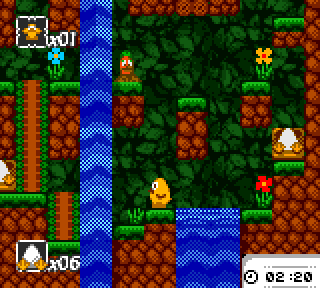One game, many platforms
At the end of 2020 the newest generation of consoles has arrived, the Playstation 5 and the Xbox Series X. Very exciting for gaming of course, but it once more demonstrates one of the many challenges of game-archiving. What to do with a game that has been released on many different consoles and other platforms? And what role can documentation play in capturing various versions of games?
At the end of 2020 the newest generation of consoles has arrived, the Playstation 5 and the Xbox Series X. Very exciting for gaming of course, but it once more demonstrates one of the many challenges of game-archiving. What to do with a game that has been released on many different consoles and other platforms? And what role can documentation play in capturing various versions of games?

Toki Tori, Two Tribes, 2008, Source: screenshot from Toki Tori for the Nintendo Wii.
By: Zena Berendse
Ever since the Netherlands Institute for Sound & Vision created the Gamescanon in 2018, many games are archived each year . One of these games is Toki Tori, which has been released on no less than twelve different platforms. Almost every version of the game is different from each other. It would be almost impossible to store every single version, not to mention, keep them up-to-date to make sure they will be playable in the future. So what are you going to keep and why?
Toki Tori is a puzzle game with platform elements, released in September 2001 for the Game Boy Color. The game follows a young chicken, Toki Tori, and his quest to rescue his younger siblings, still in their eggs. Other versions of this game were released on different platforms. Some versions were direct ports, others were enhanced versions of the original game, for example the Nintendo Wii version. Some versions even had new levels. By the game’s reception over the years, it can be concluded that it was successful because it offers good gameplay and new updates were added over the years.

Toki Tori, Two Tribes, 2001, Source: screenshot from Toki Tori for the Game Boy Color.
To preserve almost twenty years of history for a single game, documentation can be used as a preservation method. Documentation is concerned with storing secondary sources that depict, contextualise or explain a game. Sound & Vision is currently making gameplay videos and taking screenshots for the documentation as a preservation method. Research is done into collecting additional contextual materials that capture and preserve information on the context in which the game was produced and received. In the case of Toki Tori, documentation could provide information on the games’ different versions, while archiving only one or a couple of them. For example, webreviews of Toki Tori could be collected to represent the progression of the game over the years. Webreviews often start with briefly explaining the history of the game and its developer. They continue to describe the gameplay and the differences between the game on different platforms. Finally a judgment is passed. Webreviews could provide documentation on the story of the games’ development, the changes over the years and its reception, giving an idea of how Toki Tori became successful and how it evolved over the years. Why webreviews and not other forms of contextual materials, such as Let’s Plays? The importance of this game and why it was selected for the gamescanon is, because of its success and release on many platforms. Therefore, for this specific games’ story it could be argued that the commentary on the game itself as it is played is not as important, as information on how this game evolved.
Just like Toki Tori every game in the Gamescanon has its own story that makes it important to Dutch videogame history. For documentation as a preservation method, it is important to look at the games on a case-by-case basis. Every game has a different story that could be better represented by different kinds of contextual materials. For a game released on many different platforms documentation is a necessary method to preserve information about its many versions. With the arrival of a new generation of consoles it is important to think about the many things this will mean for game preservation and how new generations of consoles have affected games in the past.
Her full report can be found here.
Zena Berendse, a student of the master Preservation and Presentation of the Moving Image at UvA, is performing research at Sound & Vision into the archiving of contextual materials for the game collection.